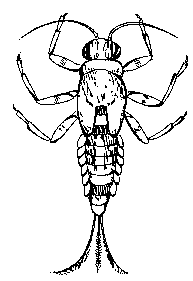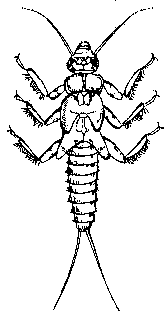Bibliography Background About KRIS
Aquatic Macroinvertebrates
 Biological monitoring, the study of biological organisms and their responses, is used to determine environmental conditions. One type of biological monitoring, the biological survey or biosurvey, is described in this chapter. The biosurvey involves collecting, processing, and analyzing aquatic organisms to determine the health of the biological community in a stream.
Biological monitoring, the study of biological organisms and their responses, is used to determine environmental conditions. One type of biological monitoring, the biological survey or biosurvey, is described in this chapter. The biosurvey involves collecting, processing, and analyzing aquatic organisms to determine the health of the biological community in a stream.
In wadable streams (streams that can be easily walked across, with water no deeper than about thigh-high), the three most common biological organisms studied are fish, algae, and macroinvertebrates. This manual discusses macroinvertebrate monitoring only.
Macroinvertebrates are organisms that are large (macro) enough to be seen with the naked eye and lack a backbone (invertebrate). They inhabit all types of running waters, from fast-flowing mountain streams to slow-moving muddy rivers. Examples of aquatic macroinvertebrates include insects in their larval or nymph form, crayfish, clams, snails, and worms (Fig. 4.1). Most live part or most of their life cycle attached to submerged rocks, logs, and vegetation.
Aquatic macroinvertebrates are good indicators of stream quality because:
- They are affected by the physical, chemical, and biological conditions of the stream.
- They can't escape pollution and show the effects of short-and long-term pollution events.
- They may show the cumulative impacts of pollution.
- They may show the impacts from habitat loss not detected by traditional water quality assessments.
- They are a critical part of the stream's food web.
- Some are very intolerant of pollution.
- They are relatively easy to sample and identify.
 The basic principle behind the study of macroinvertebrates is that some are more sensitive to pollution than others. Therefore, if a stream site is inhabited by organisms that can tolerate pollution - and the more pollution-sensitive organisms are missing - a pollution problem is likely.
The basic principle behind the study of macroinvertebrates is that some are more sensitive to pollution than others. Therefore, if a stream site is inhabited by organisms that can tolerate pollution - and the more pollution-sensitive organisms are missing - a pollution problem is likely.
For example, stonefly nymphs - aquatic insects that are very sensitive to most pollutants - cannot survive if a stream's dissolved oxygen falls below a certain level. If a biosurvey shows that no stoneflies are present in a stream that used to support them, a hypothesis might be that dissolved oxygen has fallen to a point that keeps stoneflies from reproducing - or has killed them outright.
This brings up both the advantage and disadvantage of the biosurvey. The advantage of the biosurvey is that it tells us very clearly when the stream ecosystem is impaired, or "sick," due to pollution or habitat loss. It is not difficult to realize that a stream full of many kinds of crawling and swimming "critters" is healthier than one without much life. The disadvantage of the biosurvey, on the other hand, is that it cannot definitively tell us why certain types of creatures are present or absent.
In this case, the absence of stoneflies might indeed be due to low dissolved oxygen. But is the stream under-oxygenated because it flows too sluggishly or because pollutants in the stream are damaging water quality by using up the oxygen? The absence of stoneflies might also be due to other pollutants discharged by factories or running off farmland, water temperatures that are too high, habitat degradation such as excess sand or silt on the stream bottom that has ruined stonefly sheltering areas, or other conditions. Thus a biosurvey should be accompanied by an assessment of habitat and water quality conditions in order to help explain biosurvey results.
Habitat, as it relates to the biosurvey, is defined as the space occupied by living organisms. In a stream, habitat for macroinvertebrates includes the rocks and sediments of the stream bottom, the plants in and around the stream, leaf litter and other decomposing organic material that falls into the stream, and submerged logs, sticks, and woody debris. Macroinvertebrates need the shelter and food these habitats provide and tend to congregate in areas that provide the best shelter, the most food, and the most dissolved oxygen. A habitat survey examines these aspects and rates the stream according to their quality. This chapter includes both simple and intensive habitat surveys volunteers can conduct.
Monitoring for water quality conditions such as low dissolved oxygen, temperature, nutrients, and pH helps identify which pollutants are responsible for impacts to a stream. Water quality monitoring is discussed in Chapter 5.
Uses of the Biosurvey and Habitat Assessment
The information provided by biosurveys and habitat assessments can be used for many purposes.
To screen for impairment.
Biosurveys can be used to identify problem sites along a stream. A habitat assessment can help deter- mine whether the problem is due, at least in part, to a habitat limitation such as poor bank conditions.
To identify the impact of pollution and of pollution control activities.
Because macroinvertebrates are stationary and are sensitive to different degrees of pollution, changes in their abundance and variety vividly illustrate the impact pollution is having on the stream. Loss of macroinvertebrates in the stream, or of trees along the stream bank, are environmental impacts that a wide segment of society can relate to. Similarly, when a pollution control activity takes place - say, a fence is built to keep cows out of the stream-a biosurvey may show that the sensitive macroinvertebrates have returned and a habitat assessment might find that the formerly eroded stream banks have recovered. 0 To determine the severity of the pollution problem and to rank stream sites. To use biological data properly, water resource analysts generally compare the results from the stream sites under study to those of sites in ideal or nearly ideal condition (called a reference condition). Individual stream sites can then be ranked from best to worst, and priorities can be set for their improvement.
To determine support of aquatic life uses.
All states designate their waters for certain specific uses, such as swimming or as cold water fishery. States establish specific standards (limits on pollutants) identifying what concentrations of chemical pollutants are allowable if designated stream uses are to be maintained. Increasingly, states are also developing biological criteria- essentially, statements of what biological conditions should be in various types of streams throughout the state. States are required by the Clean Water Act to report on those waters which do not support their designated uses.
Biological surveys directly examine the aquatic organisms in streams and the stressors that affect them. Therefore, these surveys are ideal tools to use in determining whether a stream's designated aquatic life uses are supported.
To identify water quality trends.
In any given site, biological data can be used to identify water quality trends (increasing or decreasing) over several years.

Order Ephemeroptera (Mayfly ) Family Ephemeriliidae Genus Drunella
Text on this page is from Volunteer Stream Monitoring: A Methods Manual. U.S. Environmental Protection Agency. 1997
Illustrations by John King from Klamath River Studies for Grades 4-6 © Copyright 1991 D. Higgins
References
CA Department of Fish and Game. 1999. California stream bioassessment procedure: Protocol brief for biological and physical/habitat assessment in wadeable streams. Aquatic Bioassessment/Water Pollution Control Laboratory. Rancho Cordova, CA. 15 pp.
U.S. Environmental Protection Agency (USEPA). 1997. Field and laboratory methods for macroinvertebrate and habitat assessment of low gradient non-tidal streams. USEPA, Mid-Atlantic Coastal Streams Workgroup. Environmental Services Division, Region 3. Wheeling, WV. 49 pp. [525kb]
U.S. Environmental Protection Agency (USEPA). 1997. Volunteer stream monitoring: A methods manual. EPA 841-B-97-003. USEPA, Office of Water. 214 pp. [2.14Mb] http://www.epa.gov/owow/monitoring/volunteer/stream/
CA Department of Fish and Game 1999 An Index of Biological Integrity for First to Third Order Russian River Tributary Streams. Water Pollution Control Laboratory. Rancho Cordova, CA
